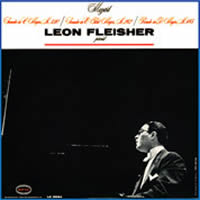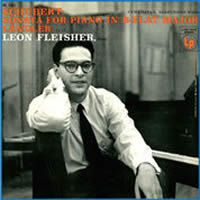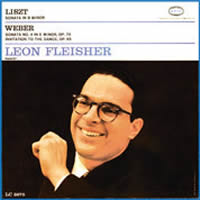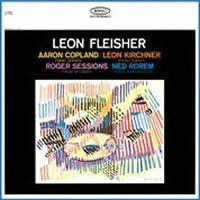Golden Oldies: The Sony Leon Fleisher Reissues
|
Dan Davis [August 2008.] To those of us of a certain age, the name Leon Fleisher conjures memories of a lavishly gifted American pianist whose Columbia and Epic recordings schooled us in many of the basic works of the piano literature. In 1965, in his mid-thirties, his career seemed at an end due to focal dystonia, a neurological impairment that left him unable to play the piano with his right hand. In the years since, Fleisher became a respected conductor and teacher, returned to the concert stage in left-handed piano repertory, and after finally overcoming the ailment, is once more a two-handed pianist whose undimmed artistry is heard on two relatively recent Vanguard releases, The Journey and Two Hands. Now, to mark Fleisher’s 80th birthday, Sony has reissued six of his solo and chamber recordings made between 1953 and 1963. One’s initial anticipation was tempered by thoughts of “what took them so long,” followed by a realization that today’s marketing realities for classical music have changed drastically. The Fleisher reissues are available from iTunes, Amazon MP3, Rhapsody, Zune and other digital outlets. If, like me, you are an audiophile or a technological dinosaur who doesn’t or won’t listen to serious music at a computer or in transit, physical CDs are available only via ArkivMusic.com’s on-demand service. The good news is that Arkiv’s Sony reissues are at mid-price; the bad news is that you can’t just pop in to your local record store and walk out with them because most of these places no longer exist. The days of leisurely browsing and serendipitous discoveries are becoming a thing of the past. None of these musings however, dim the joy of listening to the young Fleisher in his brief prime, reveling in the music and endowing it with artistic and technical resources given to few. The callow offerings of some of today’s highly publicized pianists make reissues of past giants essential listening, transcending mere nostalgia or curiosity. Some basics applicable to all six of these gems: They follow Sony’s “Original Jacket” series pattern, with covers and notes that duplicate the original LPs, and short running times — none over an hour. The remasterings by Matt Cavaluzzo and Anthony Fountain are excellent; while some are on the dry side, none are objectionable or boxy. The earlier originals were recorded in mono, the later ones in stereo. Here, I’ll focus on the five solo recordings; the sixth of the series, the Brahms Piano Quintet with the Juilliard Quartet (57340) is on the same high level as the others, a classic recording bristling with controlled energy and interpretive insights. But it’s the solo recitals that take pride of place earned by the combination of Fleisher’s pianism and their unwarranted neglect since their LP days.
Wolfgang Amadeus MOZART: Sonata in C Major, K. 330 (1781-3); Sonata in E-Flat Major, K. 282 (1775); Rondo in D Major, K. 485 (1786). Leon Fleisher (pno). Sony 57339, from Epic LC 1265. Available from ArkivMusic. Fleisher’s way with Mozart was vital and flowing, bright-toned and precise. There’s an abundance of energy in the outer movements of the C Major Sonata, and the slow movement, an andante cantabile, is sung like an operatic aria tinged with sadness. Unusual for its time, the earlier Sonata in E-Flat Major begins with an Adagio movement, another aria for piano, which Fleisher plays with molded phrasing and a tempo that never feels too slow thanks to his flexible pulse and precise articulation. His strict rhythm in the Menuetto brings out its charm, and the jaunty Allegro third movement’s fleet-fingered runs are evenly dispatched, lending a joyous feel to the music. Fleisher must love this piece; he chose it for his two-hand “comeback” recording for Vanguard, The Journey, and despite the passage of almost a half-century, timings are just seconds apart.
Franz SCHUBERT: Sonata in B-Flat Major, D. 960 (1828); Ländler, D. 790 (1823, selections). Leon Fleisher (pno). Sony 57336. Available from ArkivMusic. Here’s another disc that reflects the influence of Artur Schnabel, with whom Fleisher studied. The older pianist played Schubert and Mozart at a time when many other major artists ignored them. The Schubert B-Flat Major is now acknowledged as one of the cornerstones of the repertory and Fleisher’s, made in 1954 when he was still in his 20s, remains riveting, from the solemn, almost grim opening, the theme ending in ominous bass trills, to the final Allegro movement, played with vitality and color. In the remarkable Andante sostenuto movement, Fleisher fully captures the bleak shadows of the heart-breaking opening and subtly clarifies the theme’s upward striving to escape its inherent grimness. And Fleisher’s buoyant Scherzo sends shafts of sunlight into the gloom that precedes it, beautifully fulfilling Schubert’s con delicaza marking with light-fingered playing. What makes his performance so compelling is his perceptive understanding of Schubert’s subtext, the feeling of inevitability that underlines virtually every interpretive decision, and the way each movement is characterized with a sense of rightness. This is another piece he recorded late in his career, in the Vanguard Two Hands CD, the major difference between the two versions being the elimination of the first movement repeat in the earlier one, a common practice at the time. After the emotional roller coaster of the Sonata, the eight Ländler from the Opus 171 collection come as welcome encores, lightly played with just the right amount of swing to them.
Franz LISZT: Sonata in B Minor, S. 178 (1852-3). Carl Maria von WEBER: Sonata No. 4 in E Minor, Op. 70 (1819-22); Invitation to the Dance, Op. 65 (1819). Leon Fleisher (pno). Sony 57337. Available from ArkivMusic. The Liszt Sonata is another repertory standby, a work that can take varied interpretations and approaches. Balance was always a hallmark of Fleisher’s playing, so it should be no surprise that he balances Liszt’s extravagant rhetoric and dramatic storms with lyrical passages that reflect a poetic sensibility. It’s not a stop-and-go approach; again there’s a feeling of inevitability to the performance, with one passage leading into the next with an irresistible naturalness and none of the extreme tempo contrasts some pianists employ in place of true dramatic cohesiveness. Contributing factors once more include Fleisher’s precise articulation and his shaping of Liszt’s harmonic boldness and mood shifts. In Fleisher’s hands the Weber Sonata sounds like the groundbreaking work it is. Konrad Wolff’s booklet notes say that “Weber, in this late work, was on the track of a new language of music in which, for the first time, passions and states of mind could be communicated.” I’d heard Claudio Arrau’s fine recording of the piece but its full embodiment of Romantic ethos never fully sank in until I heard this Fleisher version. There’s a controlled wildness to his playing here that comes as close to “definitive” as you can get. Add his delicious version of Weber’s Invitation to the Dance, and this may just be the gem of this reissue series, the one to have if you’re having only one.
Claude DEBUSSY: Suite bergamasque (c. 1890, rev. 1905). Maurice RAVEL: Sonatine (1903-5); Valses nobles et sentimentales (1911); Miroirs: Alborada del gracioso (1904-5). Leon Fleisher (pno). Sony 57307. Available from ArkivMusic. While Fleisher was not a colorist in the sense that some keyboard giants were, e.g., Gieseking, he did command a wide enough palette, obvious in the discs mentioned above. But his Suite bergamasque is free from any hint of the pedaled mists that enshrouded Debussy in the 1950s. His emphasis is on clarity and precise articulation, even in the third and most famous of the set, Clair de lune. Ravel’s keyboard music, with its sense of form and balance, is friendly to Fleisher’s modernist approach. He brings delicacy to the concise Sonatine’s first movement and excitement to the third, with manifold details that never upset the work’s melodic or rhythmic flow. In the Valses, he tears into the opening statement and plays many of the seven dances with an endearing spontaneity, while the slow Epilogue really gives you the sense of weary dancers and dimming ballroom lights. The Alborada del gracioso is as colorful as one could want, crackling with Spanish rhythms and capturing a sultry Andalusian night.
Aaron COPLAND: Piano Sonata (1939-41). Roger SESSIONS: From My Diary (1937-9, selections). Leon KIRCHNER: Piano Sonata (1948). Ned ROREM: Three Barcarolles (1949). Leon Fleisher (pno). Sony 57338. Available from ArkivMusic. Fleisher’s 1962 all-American disc displays his empathy with what was then “new” music, extending from Copland’s more formal sonatas, to Kirchner and Ned Rorem’s insouciant Three Barcarolles, played with relaxed ease. The selections from Roger Sessions’ From My Diary may not be among his groundbreaking works, but the modernist language in these four pieces is there, and they run the gamut from reflective to energetic, melodic to assertive, all of which Fleisher performs brilliantly. Copland’s Sonata demands to be heard more often. The first movement requires that sense of balance that seems second nature for Fleisher, whose handling of contrasts, varied sonorities, and chordal writing is exemplary. The jazzy second movement Vivace glitters, slowing as it transitions to the final and longest movement, an Andante sostenuto that Fleisher plays with an improvisatory simplicity, sustaining a sense of timelessness that acts as a foil to the more active central section, making it even more powerful as it flares with energy. It’s a great performance, as is his rendition of the Kirchner Sonata, another work that’s modern and timeless in its language and emotions.
[More Dan Davis]
[Previous Article:
Mostly Symphonies 7.]
[Next Article:
What, More Words? 1.]
|




